1. READ. What a concept! Don't read for the teacher, or read for a grade-read for yourself. Nothing changes you like reading. Nothing increases your curiosity, intellect, and knowledge like reading. Someday you will be asked, perhaps by your own children, "Hey, did you ever read
Hamlet?" And of course you'll say, "Yeah, senior year in high school." Only
you will know if
you cheated yourself out of reading it. Only
you will know that
you didn't meet the challenge, and that
Hamlet beat you.
If you heard a film was fabulous, would you ask a friend or online critic to summarize it for you, assuming their summaries are as good as experiencing it yourself? Of course not. Then why rob yourself out of experiencing famous literature and creating opinions that are solely YOURS?
2. Listen to your inner voices. Yep, they're normal.
You have three inner reading voices.
The
first voice is the voice in your head, reading the lines. It's your reading voice, sounding out the words, reading the sentences.
The
second voice is the one that responds to the text. It says things like, "Huh? What's going on? I forgot who that character is again...let me go back and check..." or "Ugh! Her best friend slapped her! I'd hit her back...or walk away...yeah, right....Well, she kind of deserved it after betraying her..."
The
third voice is your distracting voice, the one that starts leading you on a tangent, such as, "I remember when my friend did that to me. At my locker. I hope my locker doesn't get stuck tomorrow. I'll have to go to the office for help, and I'll look like an idiot. Hee hee, that kid who fell at lunch was an idiot...Oh, crap, I've read two pages and I have no idea what happened. Oh well, I'll keep reading from here and figure it out...Oh, yeah, I still have math homework, crap..."
Obviously, you need the first and second voices. If you only hear the first one, however, you are not THINKING while reading, and later you won't remember any of it. You need the second voice to grasp the information, to connect yourself to what's going on, and to question which parts you understand and which parts are confusing you.
You need to pay attention when the third voice takes over, and then get back on track as soon as possible. Even good readers have third voices distracting them, but the difference between good readers and poor readers is that good readers go back to the point when the third voice took over, and they REREAD.
3. Reread, using the strategies below. (Ugh!)
4. Design a reading environment specifically for you.
Good readers create environments that help them to focus. You need a quiet spot to read, a place that allows you to focus, a place that is comfortable and suitable for your specific needs. Some people can read at a desk, while others prefer a comfy chair in a corner of a room. Some people can read in a bed, while others instantly fall asleep. Find a place that inspires you and helps you to stay focused and think.
Turn off the television, computer, video games, and any music. While background noise sometimes helps people focus on tasks, background noise is inappropriate during reading since it blocks you from hearing your first and second inner voices. If your house is full of loud siblings, try reading in an attic, basement, or closet. Sounds silly, but it works. And no one says you have to do homework at home. Some people read better outdoors or in a public building, like a library or coffee shop. Students sometimes find it easiest to read in school during a quiet study hall or after school in an empty classroom.
It is important to figure out if you are an
auditory learner, someone who learns by hearing things. Auditory learners find it easier to focus if they read the material aloud or follow along to the book on audio. However, other people find oral reading distracting because the material takes over and they can't hear their second inner voice. Experiment to figure out what environment works best for you.
5. Figure out the main idea.
Stop yourself every page (or paragraph if you need to) and ask your second voice to summarize the information. If you do not know the main idea, go back and reread that section. This will prevent your third voice from taking over too often, thus wasting your time.
6. Know WHY you are reading something.
Don't think of the reading as an assignment. Think about it as a challenge to gain more knowledge.
Have a
purpose. For instance, when good readers have to read, say, Chapter 12 for homework, they start by asking themselves, "What happened in Chapter 11? Where was I?"
Good readers also ask teachers if there are things to
focus on. Perhaps in Chapter 12, a character will change drastically. That's good to know ahead of time, so when you read Chapter 12, you can look for the change.
For example, if you were given the newspaper, you would not read it cover to cover. You would read with a purpose in mind. Perhaps you'd head straight for the Sports section, or the Comics, or the Horoscopes, or the Weather, or, strangely enough, the News. Imagine if you had to read the entire newspaper, and then take a quiz on it. Impossible! Read with a focus.
Also, good readers
notice important details.If something is
repeated, such as a word, phrase, image, setting, or a strange detail, it's important! Think about why the writer keeps repeating it.
Teachers sometimes give questions for homework to check for understanding and to help students focus. Good readers actually read the assignment, and then answer the questions as thoughtfully as possible. Poor readers try to copy the good readers' answers, or they skim the reading and give minimal responses. They later complain that they did the reading and still failed the quizzes and tests. They never
experienced the reading, letting it invade their thoughts and challenge their knowledge.
Who knew that reading involved thinking, effort, and endurance?
7. Visualize what you are reading.
Pretend you are a director, turning the text into a movie. What do you see? What does the setting look like? What do characters look like? What are they wearing? What facial expressions should they make? How should they deliver dialogue? Can you hear their voices? Can you guess what will happen next?
8. Make connections to what you are reading.
Connecting to what you are reading is the best way to remember what you've read.
·Allow your second voice time to
relate the text to a personal experience.
·
Compare it to another text you've read, or to a film you've seen.
·
Recall any other background information you have about the subject (especially new information the teacher may have provided in class.)
·
Write down interesting questions or comments that your second voice thinks. Note lines or paragraphs that confuse you. This is called
active reading. Since you cannot highlight or write in most textbooks,
use sticky notes in the margins of the text to keep track of your questions.
9.
Ask specific questions to get specific answers.
Pretend the text is a puzzle of details that you must piece together to get the full picture. Sometimes you need help fitting the pieces together. Never simply tell the teacher, "I didn't get it." Instead say, "On page 49, I didn't understand who was talking. The dialogue was weird, and then the characters kissed, and I didn't even know they liked each other!" The teacher can then discuss the minor details that help readers to see that they liked each other, such as passionately expressing their hatred for each other, and yet talking for hours together. Chances are other students will be stuck on the same parts, not putting the details together correctly.
10. Pay attention to the actual structure of the reading.
If a chapter has a title, read it. If sections have titles, read them. Think about them. As you read, figure out why the title matches the section.
Pay attention to FONT and PUNCTUATION. If things are
bold,
underlined, or ALL CAPITALIZED, they are important. If a word or phrase is
italicized, perhaps it is a new vocabulary word, a foreign word, or a word that should be emphasized for tone to clarify the meaning of the sentence.
This handout has a structure, so you should never have to read the entire sheet again. Items are numbered and spaced for reading ease. Headings are in bold to remind you of the key strategies. Specific strategies and essential points have been italicized. Bullets are used for bulky lists to help breakdown reading into specific chunks. Breaking facts down into smaller pieces makes them easier to remember, and easier to reread and study later. That's why
outlining a chapter is sometimes a useful tool.
11. Slow down or speed up.
Pace yourself. Think of reading as a marathon that you want to finish. You will give up if you read so quickly that you miss the meaning, and then have to start all over again to understand. No runner runs a race at the same pace. They also do not quit when they hit a hill. Slow down when things get harder and your second voice is confused. Read only one sentence at a time, and then figure out what that sentence means. Good readers also slow down when something crucial or exciting happens so they don't miss anything.
Speed up when the reading is easier, or if you are getting bored. Momentum can stop boredom and stop you from falling asleep. You would never want to listen to a speech all at one speed, so why would you want to read something at one, boring pace?
12. Use a dictionary.
If you cannot figure out the meaning of a new word using
context clues, use a dictionary to build your vocabulary. This might seem like a waste of time, but sometimes you may not understand an entire paragraph because of one word. Rather than struggling for pages and rereading for clarity, taking a minute to look up a word in a dictionary could actually save you time.
13. Read for pleasure.
Reading is the only way to become a better reader. Read anything and everything that you want to read. Many good readers visit the library on a regular basis. Some people are afraid of libraries--something tragic usually happened to them as children involving fines and lost videos. If you are one of these poor souls, it's time to get over it and talk to a librarian. It always fascinates me that whenever I run into students at the library, they are always the strongest readers in my classes.
Marathon runners cannot expect to make it to the finish line without training for the race, running more and more each day. Reading classics and textbooks for school
is the marathon. How can you ever expect to reach the finish line if you never practice along the way?
Bibliography: Tovani, Cris.
I Read It, But I Don't Get It: Comprehension Strategies for Adolescent Readers. Portland:Stenhouse, 2000.
Source-
Kristy Acevedo, Yahoo! Contributor Network
http://voices.yahoo.com/strategies-improving-teen-reading-comprehension-684915.html?cat=4


 at B. According to Theorem 73,
at B. According to Theorem 73, 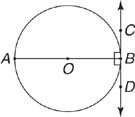
 is tangent to the circle at P,
is tangent to the circle at P,  is tangent to the circle at S. Use these facts to find the center of the circle.
is tangent to the circle at S. Use these facts to find the center of the circle. 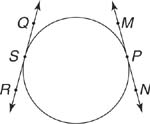
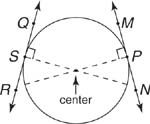
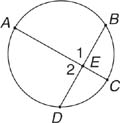

 meet at R. By Theorem 76, m ∠1 = 1/2 ( m
meet at R. By Theorem 76, m ∠1 = 1/2 ( m ) and m ∠ 2 = ½ ( m
) and m ∠ 2 = ½ ( m ).
). 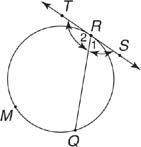
 and
and  intersect at G. According to Theorem 77, m ∠1 = 1/2( m
intersect at G. According to Theorem 77, m ∠1 = 1/2( m – m
– m ).
). 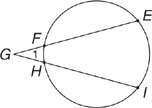
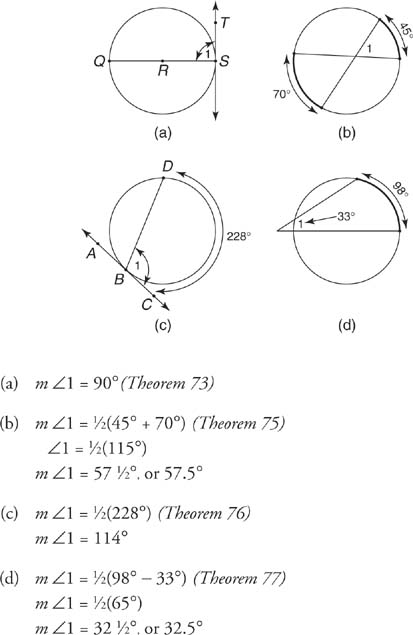

 is its intercepted arc.
is its intercepted arc. 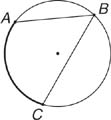
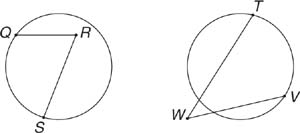
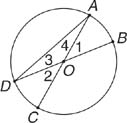
 , and m ∠4 is half of m
, and m ∠4 is half of m ∠3 and ∠4 are inscribed angles, and
∠3 and ∠4 are inscribed angles, and 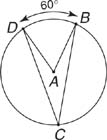

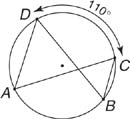

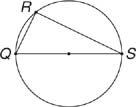
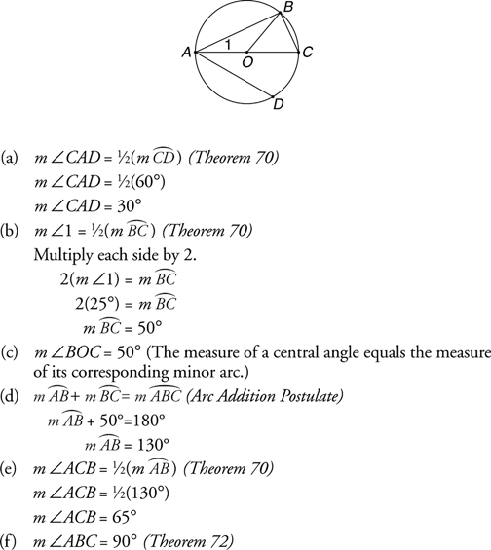

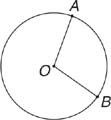
 is a semicircle.
is a semicircle. 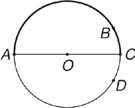
 is a minor arc of circle P.
is a minor arc of circle P. 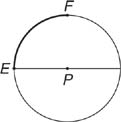
 is a major arc of circle Q.
is a major arc of circle Q. 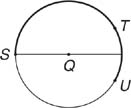
 and (b) l
and (b) l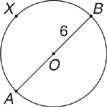










 = 140° (By Postulate 18, m
= 140° (By Postulate 18, m is a semicircle, so m
is a semicircle, so m



